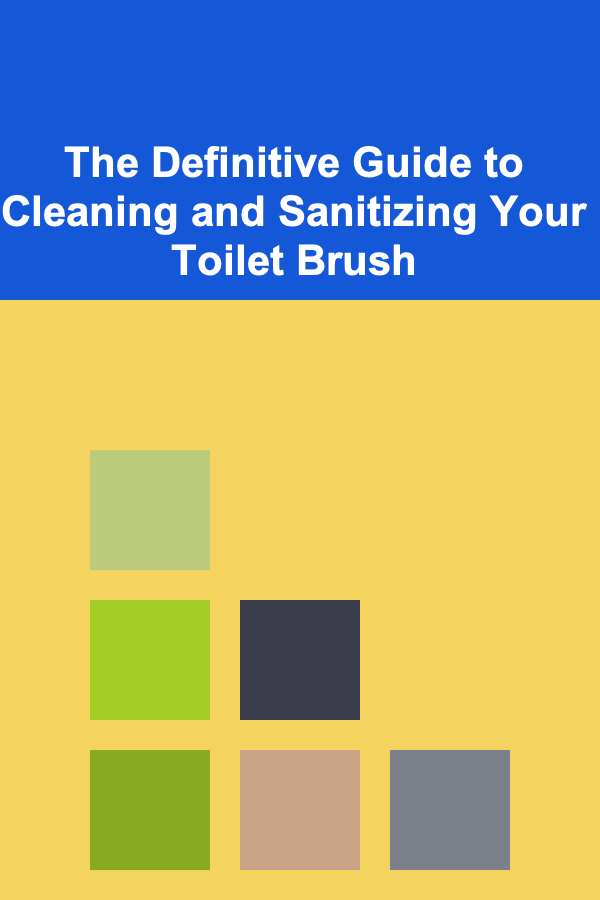
The Definitive Guide to Cleaning and Sanitizing Your Toilet Brush
ebook include PDF & Audio bundle (Micro Guide)
$12.99$9.99
Limited Time Offer! Order within the next:

Introduction: Why This Isn't Just About Cleanliness
The toilet brush. It's an unsung hero in the fight against bathroom grime, a tool we rely on to maintain hygiene and keep our toilets sparkling. But let's face it, it's also something most of us don't think about cleaning itself. This is a significant oversight, as a dirty toilet brush is not only ineffective but also a breeding ground for bacteria and germs, potentially turning it into a health hazard rather than a cleaning aid.
Beyond the obvious aesthetic concerns, the consequences of neglecting your toilet brush's cleanliness can be far-reaching. From unpleasant odors lingering in your bathroom to the potential spread of harmful microorganisms, the stakes are higher than simply a visually unappealing cleaning tool. This comprehensive guide will delve into the importance of proper toilet brush hygiene, exploring the risks of neglecting it and providing step-by-step instructions for effective cleaning and sanitization.
We'll cover everything from choosing the right cleaning solutions to implementing preventative measures that will keep your brush clean and sanitary for longer. By the end of this guide, you'll understand not just how to clean your toilet brush, but why it's so crucial for a truly clean and healthy bathroom environment. We'll also address common misconceptions and provide practical tips to integrate toilet brush maintenance into your regular cleaning routine.
The Grim Reality: What Lives on Your Dirty Toilet Brush
Before we dive into the "how-to," let's confront the unsettling truth about what thrives on a neglected toilet brush. Think of it as a miniature ecosystem, flourishing with a variety of microorganisms.
- Bacteria: This is the most common culprit. Fecal bacteria, including E. coli and other coliform bacteria, are virtually guaranteed to be present after each use. These bacteria can cause gastrointestinal issues and, in some cases, more serious infections. Beyond fecal bacteria, various other environmental bacteria can also colonize the brush.
- Mold and Mildew: The damp environment within the toilet brush holder is ideal for mold and mildew growth. These fungi can trigger allergies and respiratory problems, especially in individuals with sensitivities. The dark, enclosed space further promotes their proliferation.
- Viruses: While less common than bacteria or mold, viruses can also survive on a toilet brush, particularly if someone using the toilet is ill. Norovirus, for example, is highly contagious and can easily contaminate surfaces.
- Other Organic Matter: Beyond microorganisms, the brush also accumulates residue from toilet water, cleaning products, and general bathroom dust and debris. This organic matter provides nutrients that further fuel the growth of bacteria and mold.
Ignoring this microbial menagerie doesn't just mean a visually unappealing brush. It means you're effectively reintroducing these contaminants back into your toilet bowl each time you clean, potentially spreading them to other surfaces in your bathroom, like the toilet seat, handle, and even the floor.
Important Note: A seemingly clean toilet brush can still harbor harmful microorganisms. Visual cleanliness is not an indicator of sanitization. Regular and thorough cleaning is essential to eliminate these threats.
Furthermore, consider the potential for cross-contamination. Touching the brush after cleaning and then touching other surfaces can easily transfer these microorganisms. This highlights the importance of proper hand hygiene after handling the toilet brush.
Step-by-Step Guide: Cleaning and Sanitizing Your Toilet Brush
Now that we understand the stakes, let's get down to the business of cleaning. This comprehensive guide outlines a multi-step process for effectively cleaning and sanitizing your toilet brush:
Step 1: Initial Rinse and Shake
This is the most crucial step you should perform after every use. After cleaning the toilet bowl, hold the brush over the bowl and rinse it thoroughly with clean toilet water. This removes the majority of visible debris and initial contaminants.
After rinsing, firmly shake the brush over the toilet bowl to remove excess water. This helps to prevent water from pooling in the brush holder, which creates a breeding ground for bacteria and mold. Aim to remove as much water as possible.
Step 2: Disinfecting the Brush
This step requires the use of a disinfectant. You have several options:
- Toilet Bowl Cleaner: The most convenient option. After rinsing the brush, squirt a generous amount of toilet bowl cleaner onto the bristles while holding it over the toilet bowl. Allow the cleaner to sit for at least 10 minutes, preferably longer. The longer the contact time, the more effective the disinfection.
- Bleach Solution: A powerful disinfectant. Prepare a solution of 1 part bleach to 9 parts water. Submerge the brush head in this solution for at least 30 minutes. Caution: Wear gloves and eye protection when handling bleach. Ensure proper ventilation and never mix bleach with ammonia or other cleaning products, as this can create toxic fumes.
- Hydrogen Peroxide: A gentler alternative to bleach. Use a 3% hydrogen peroxide solution. Submerge the brush head for at least 30 minutes. While less harsh than bleach, hydrogen peroxide is still an effective disinfectant and is safer for the environment.
- Vinegar: A natural disinfectant, though less potent than bleach or hydrogen peroxide. Submerge the brush head in undiluted white vinegar for at least an hour. Vinegar is a good option for those seeking a more eco-friendly approach.
- Commercial Disinfectant Sprays: Many disinfectant sprays are effective against a broad range of bacteria and viruses. Spray the brush head thoroughly, ensuring all bristles are covered. Follow the manufacturer's instructions for contact time.
Regardless of the disinfectant you choose, ensure the brush head is completely submerged (or thoroughly coated if using a spray) and allow sufficient contact time for the disinfectant to work effectively.
Step 3: Thorough Rinsing
After the disinfectant has had its contact time, it's crucial to rinse the brush thoroughly with clean water. Residual disinfectant can damage the brush bristles and potentially irritate skin if touched. Hold the brush under running water (either from a faucet or using the toilet's flushing mechanism) until all traces of the disinfectant are gone.
Step 4: Final Shake and Drying
Repeat the shaking process from Step 1 to remove as much excess water as possible. This is a critical step in preventing mold and mildew growth. The drier the brush, the less hospitable it is to these microorganisms.
Ideally, allow the brush to air dry completely before returning it to its holder. This can be achieved by leaning the brush against the side of the toilet bowl or by using a specially designed brush holder that allows for ventilation.
Step 5: Cleaning the Toilet Brush Holder
Often overlooked, the toilet brush holder is a prime breeding ground for bacteria and mold. Empty the holder and scrub it thoroughly with hot, soapy water. Rinse well and disinfect using the same solutions mentioned in Step 2 (bleach, hydrogen peroxide, or vinegar). Allow the holder to dry completely before returning the clean brush.
Pro Tip: Consider drilling a few small drainage holes in the bottom of your toilet brush holder to allow excess water to escape and promote better air circulation. This will significantly reduce the risk of mold and mildew growth.
Choosing the Right Tools and Cleaning Solutions
The effectiveness of your toilet brush cleaning routine depends not only on the technique but also on the tools and solutions you employ. Here's a guide to making informed choices:
Toilet Brush Selection: Bristle Type and Design
- Bristle Material: Look for brushes with durable, non-absorbent bristles. Plastic or nylon bristles are generally preferred over natural bristles, as they are less likely to harbor bacteria.
- Bristle Density: A brush with densely packed bristles will provide more effective cleaning power and is less likely to wear down quickly.
- Brush Head Shape: Consider a brush with an angled head to reach under the rim of the toilet bowl more easily.
- Handle Length and Grip: Choose a brush with a comfortable handle length and a secure grip to prevent slippage.
- Replaceable Heads: Some brushes have replaceable heads, which is a more sustainable and hygienic option than replacing the entire brush.
Cleaning Solution Considerations
- Toilet Bowl Cleaner: Choose a toilet bowl cleaner that contains disinfecting agents, such as bleach or quaternary ammonium compounds. Ensure the cleaner is compatible with your toilet bowl material (e.g., avoid abrasive cleaners on delicate surfaces).
- Bleach: A powerful disinfectant, but use with caution. Always dilute properly (1 part bleach to 9 parts water), wear gloves and eye protection, and ensure adequate ventilation. Avoid using bleach on colored or patterned toilet bowls, as it can cause discoloration.
- Hydrogen Peroxide: A gentler alternative to bleach, but still effective against many bacteria and viruses. A 3% solution is readily available and safe for most surfaces.
- Vinegar: A natural and eco-friendly option. White vinegar is a good choice for general cleaning and disinfecting, but it may not be as effective as bleach or hydrogen peroxide against certain microorganisms.
- Commercial Disinfectant Sprays: Ensure the spray is EPA-registered and effective against a broad range of pathogens. Follow the manufacturer's instructions for contact time and proper use.
Safety First: Always read and follow the manufacturer's instructions for all cleaning products. Never mix bleach with ammonia or other cleaning products, as this can create dangerous fumes. Store cleaning products out of reach of children and pets.
Maintaining a Clean Toilet Brush: Preventative Measures
Cleaning your toilet brush is important, but implementing preventative measures can significantly reduce the frequency and intensity of cleaning required. Here are some key strategies:
- Rinse After Every Use: As mentioned earlier, rinsing the brush thoroughly after each use is the most crucial preventative measure. This removes the majority of debris and prevents the buildup of grime.
- Regular Disinfection: Disinfect the brush at least once a week, even if it appears clean. This helps to control the growth of bacteria and mold.
- Use a Toilet Bowl Cleaner with Disinfectant: Incorporate a toilet bowl cleaner with disinfecting properties into your regular toilet cleaning routine. This will help to keep the brush cleaner for longer.
- Proper Ventilation: Ensure your bathroom is well-ventilated to reduce humidity and prevent mold growth. Open a window or use an exhaust fan after showering or bathing.
- Choose the Right Brush Holder: Select a brush holder that allows for adequate ventilation and drainage. Avoid holders that trap water. Consider models with drainage holes or raised platforms.
- Store the Brush Properly: After cleaning and disinfecting, allow the brush to air dry completely before returning it to its holder. Leaning it against the toilet bowl rim can help with drying.
- Replace Your Toilet Brush Regularly: Even with proper cleaning, toilet brushes eventually wear down and become less effective. Replace your brush every 6-12 months, or sooner if the bristles are damaged or discolored.
Troubleshooting Common Problems
Even with the best intentions, you might encounter some common problems when cleaning and sanitizing your toilet brush. Here's how to troubleshoot them:
- Persistent Odor: If your toilet brush still smells unpleasant after cleaning, it may be due to deep-seated bacteria or mold. Try soaking the brush in a stronger disinfectant solution (bleach or hydrogen peroxide) for a longer period. You may also need to replace the brush if the odor persists.
- Bristle Discoloration: Discoloration of the bristles is often caused by mineral deposits from hard water or staining from toilet bowl cleaner. While discoloration doesn't necessarily indicate unsanitary conditions, it can be unsightly. Try soaking the brush in vinegar to remove mineral deposits.
- Mold Growth in the Brush Holder: Prevent mold growth by ensuring the brush holder is clean and dry. Clean the holder regularly with hot, soapy water and disinfectant. Consider drilling drainage holes in the bottom of the holder.
- Difficulty Reaching Under the Rim: If your brush doesn't effectively clean under the toilet bowl rim, consider switching to a brush with an angled head or using a specialized rim cleaner.
- Deteriorating Bristles: Bristles that are frayed, bent, or falling out indicate that the brush needs to be replaced. Prolonged exposure to harsh cleaning chemicals can also contribute to bristle deterioration.
Beyond the Brush: A Holistic Approach to Bathroom Hygiene
Cleaning your toilet brush is an important part of bathroom hygiene, but it's just one piece of the puzzle. A holistic approach involves maintaining overall cleanliness throughout your bathroom to minimize the spread of germs and bacteria.
- Regular Toilet Cleaning: Clean your toilet bowl at least once a week, or more frequently if needed. Use a toilet bowl cleaner that contains disinfecting agents.
- Wipe Down Surfaces: Regularly wipe down all surfaces in your bathroom, including the toilet seat, handle, sink, countertops, and floor, with a disinfectant cleaner.
- Clean the Toilet Flange: Don't forget to clean the toilet flange (the area around the base of the toilet). This area can accumulate dirt and grime.
- Proper Hand Hygiene: Wash your hands thoroughly with soap and water after using the toilet and after cleaning the bathroom.
- Ventilation: Ensure your bathroom is well-ventilated to reduce humidity and prevent mold growth.
- Clean Bath Mats and Rugs: Wash bath mats and rugs regularly according to the manufacturer's instructions.
- Replace Toothbrushes Regularly: Replace your toothbrush every 3 months, or sooner if you've been sick. Store your toothbrush in an upright position and allow it to air dry.
- Separate Cleaning Cloths: Use separate cleaning cloths for different areas of the bathroom to prevent cross-contamination.
By adopting a holistic approach to bathroom hygiene, you can create a cleaner, healthier, and more pleasant environment for yourself and your family.
Conclusion: A Small Effort, a Big Impact
Cleaning and sanitizing your toilet brush may seem like a minor task, but its impact on overall bathroom hygiene and your health should not be underestimated. By following the steps outlined in this guide and incorporating preventative measures into your routine, you can keep your toilet brush clean, sanitary, and effective for longer.
Remember, a clean toilet brush is not just about aesthetics; it's about protecting yourself and your family from harmful bacteria, viruses, and mold. Investing a few minutes each week to properly clean and maintain your toilet brush is a small price to pay for a healthier and more hygienic bathroom environment. Embrace these practices, and you'll be well on your way to a truly clean and healthy home.

How to Build a Checklist for Staying Creative During Content Creation
Read More
How to Create a Digital Nutrition Guide: A Step-by-Step Actionable Guide
Read More
How to Maintain Your Home's Lawn Sprinkler System
Read More
How to Use These Tips for Saving on Taxes and Lowering Your Liability
Read More
Mastering Procurement Management: Advanced Strategies for Cost Reduction and Value Creation
Read More
How to Plan for Financial Independence
Read MoreOther Products

How to Build a Checklist for Staying Creative During Content Creation
Read More
How to Create a Digital Nutrition Guide: A Step-by-Step Actionable Guide
Read More
How to Maintain Your Home's Lawn Sprinkler System
Read More
How to Use These Tips for Saving on Taxes and Lowering Your Liability
Read More
Mastering Procurement Management: Advanced Strategies for Cost Reduction and Value Creation
Read More